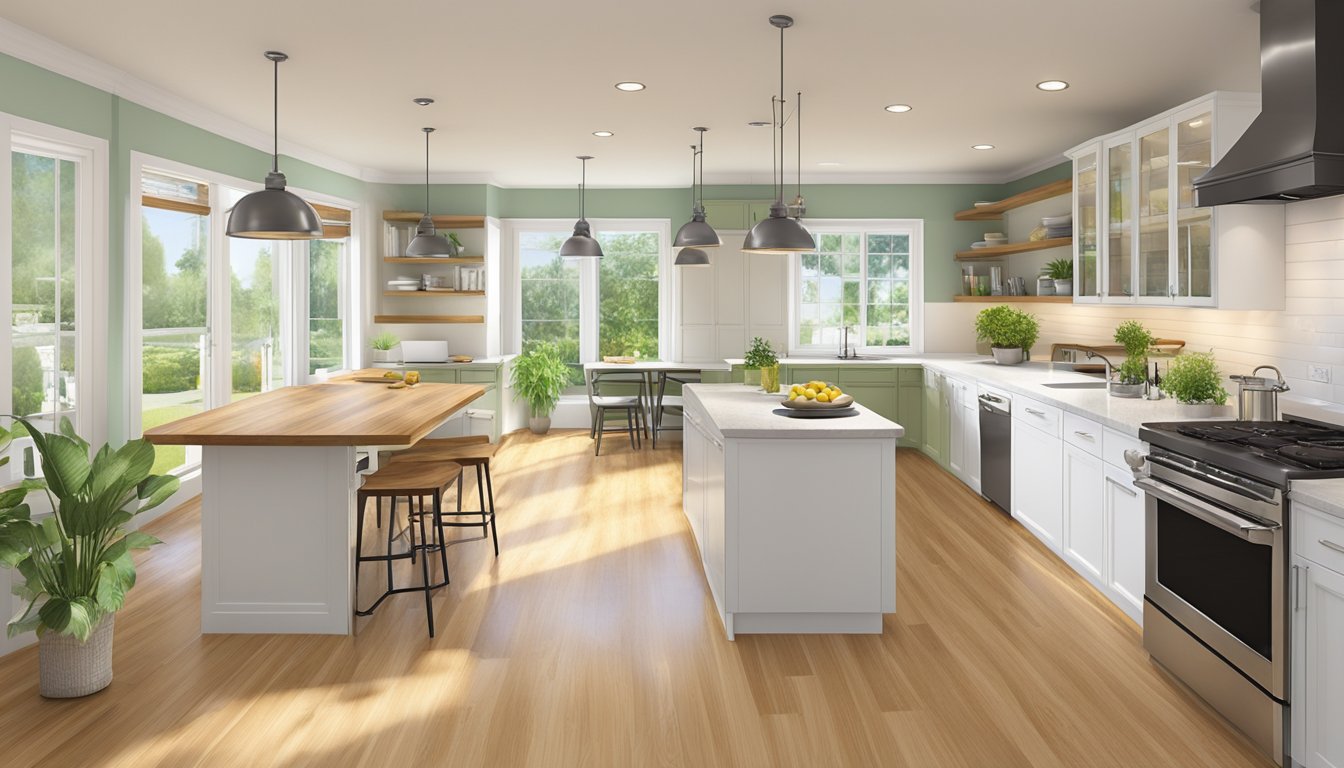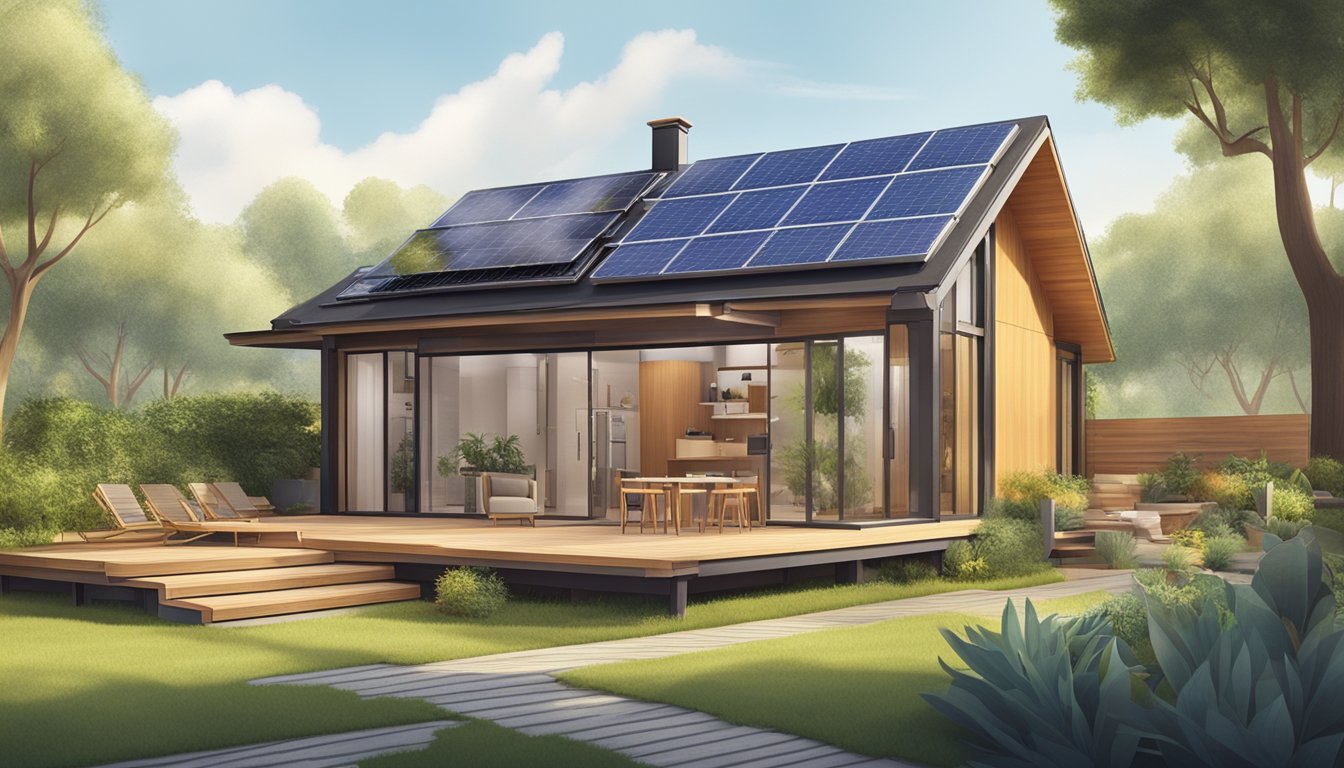Improving a home today goes beyond aesthetics and comfort; sustainability is now a key consideration for many homeowners.
Eco-friendly home improvement involves incorporating environmentally responsible products and practices that reduce a home’s carbon footprint and promote energy efficiency.
By focusing on sustainable home improvements, individuals can minimise the environmental impact of their living spaces.
This approach includes measures such as installing energy-efficient appliances, utilising environmentally friendly building materials, and implementing water-conservation techniques.
Moreover, eco-friendly home improvement is not just about making a single green choice; it encompasses a comprehensive strategy to enhance the home’s overall sustainability.
It combines energy solutions like solar panels with insulation and weatherisation to improve thermal performance.
Home renovations that prioritise indoor air quality and natural ventilation contribute to healthier living environments, while landscaping and sustainable resource management further align home improvement efforts with eco-conscious goals.
Key Takeaways
- Eco-friendly home improvements reduce environmental impacts and promote sustainability.
- Sustainable renovations encompass energy efficiency, eco-friendly materials, and water conservation.
- Eco-conscious strategies contribute to healthier living spaces and resource management.
Understanding Eco-Friendliness in Home Improvement
When considering home enhancements, it’s crucial to incorporate eco-friendly and sustainable practices. Such revisions not only benefit the environment but often provide long-term cost savings for homeowners.
Defining Eco-Friendly and Sustainable Practices
Eco-friendly home improvement involves using materials and technologies that have minimal impact on the environment.
Sustainable practices go further, ensuring that resources are used in a way that doesn’t deplete them for future generations.
Products that carry the Energy Star certification from the U.S. Department of Energy and the Environmental Protection Agency, for example, meet strict energy efficiency guidelines.
The Importance of Reducing Carbon Footprint in Homes
A home’s carbon footprint is the amount of carbon dioxide and other carbon compounds emitted due to the energy used within it.
By reducing energy consumption and using renewable energy sources, households can significantly lower their carbon dioxide emissions, contributing to a reduction in global warming and climate change.
Energy Efficiency as a Cornerstone of Eco-Friendly Improvements
Energy efficiency is at the heart of green home improvements.
It involves using less energy to perform the same tasks, therefore reducing energy waste.
For example, energy-efficient appliances save money on utility bills and often perform better than their traditional counterparts.
Incorporating energy-efficient windows and insulation can also drastically reduce the need for heating and cooling.
Legislation and Incentives for Eco-Friendly Upgrades
The government often encourages eco-friendly upgrades through legislation and incentives.
For instance, homeowners may receive tax credits, rebates, or subsidies when they install Energy Star certified products or renewable energy systems.
These incentives serve to lower the upfront costs of eco-friendly improvements and bolster the transition towards sustainability in housing.
Eco-Friendly Energy Solutions
Exploring eco-friendly energy solutions offers a myriad of benefits for homeowners, including the potential to save money on energy bills while also reducing environmental impact.
This section delves into innovative ways to harness renewable energy sources and manage energy consumption efficiently.
Solar Power Innovations for Homes
The adoption of solar panels continues to be a game-changer for energy-efficient homes.
Cutting-edge photovoltaic (PV) technology not only allows homeowners to harness solar energy but also to markedly reduce their reliance on traditional power grids.
Recent advancements in solar photovoltaic systems have improved their efficiency and integration into standard roofing materials, making solar energy more accessible than ever before.
Alternative Heating Systems
Heating systems such as air source heat pumps and ground source heat pumps present environmentally friendly alternatives to conventional boilers.
These systems absorb heat from the air or ground, which is then used to warm the home.
Moreover, a biomass boiler, utilising sustainable materials, can offer another renewable heating solution providing a low-carbon footprint while also maintaining your home toasty during colder months.
Harnessing Renewable Energy Sources
In the realm of renewable energy, solar energy shines, but there are more options available to those looking to make their homes eco-friendly.
From solar thermal systems providing hot water to underfloor heating distributing warmth efficiently, these renewable solutions can significantly increase a home’s energy efficiency.
Smart Home Technologies for Energy Management
Intelligent energy management systems, typified by products like Google Nest, offer homeowners a way to save money while optimising comfort.
With a smart thermostat, individuals can control their heating and cooling systems remotely, ensuring energy is only used when necessary.
These smart technologies enable detailed monitoring of energy usage, leading to informed decisions that drive down energy bills.
Home Insulation and Weatherisation
In the pursuit of a sustainable and energy-efficient home, proper insulation and weatherisation are imperative. They not only save money for homeowners but also contribute to a comfortable living environment.
Key materials and technologies can be employed to enhance the efficiency of these improvements.
Insulating Walls and Ceilings Effectively
The right wall insulation can massively reduce energy loss, with options like hemp and cork offering high R-values.
Cork, in particular, provides a unique balance of sustainability and insulation capability, due to its natural properties.
A material’s R-value measures its resistance to heat flow—the higher the number, the better the insulating power.
Homeowners should consider insulation made from eco-friendly materials that not only insulate but also have a minimal environmental impact.
Advanced Window Technologies
Advancements in window technologies present numerous options for energy conservation.
Double glazing is the standard for energy-efficient windows, helping to reduce heat loss.
Modern glazing incorporates low-emissivity (low-e) coatings, which reflect infrared energy (heat) while allowing light to pass through.
Additionally, during colder months, thermal curtains can complement these windows by providing an extra layer of insulation, leading to further energy savings.
Air Sealing Techniques
Effective air sealing is crucial in preventing unwanted drafts from entering a home, therefore maintaining thermal comfort and reducing heating costs.
Various air sealing techniques involve the use of materials such as weather stripping and caulk to seal gaps and cracks around doors and windows.
For larger gaps, expanding foam or other insulation types can be used.
Homeowners can apply a clear glaze to enhance the seal while maintaining the appearance of the woodwork.
Eco-Friendly Home Building and Decoration Materials
When considering eco-friendly home improvements, homeowners have a plethora of sustainable materials and products at their disposal. These options not only contribute to a greener planet but also can improve the overall energy efficiency and aesthetics of a home.
Sustainable Flooring Options
Bamboo Flooring: Bamboo is a highly renewable resource that matures in as little as three to five years, making bamboo flooring a sustainable choice.
Its durability rivals that of traditional hardwood floors, and it comes in various grains and shades to match any decor.
Recycled Materials: For those interested in unique flooring, using recycled materials like glass tiles offers an eco-friendly solution with a modern twist.
Organisations such as Habitat for Humanity’s ReStore are excellent places to source such materials.
Non-Toxic and Eco-Friendly Paints
Paints that have low or zero Volatile Organic Compounds (VOCs) are safer for both the environment and the home’s inhabitants.
Eco-friendly paint options have improved in quality, providing durability and a wide range of colours without the harmful chemicals found in traditional paints.
Furniture and Fixtures from Sustainable Resources
Furniture: Furniture from sustainable resources includes pieces made from reclaimed wood or repurposed materials. This reduces waste and adds character to a home’s interior.
Lighting and Plumbing Fixtures: Look for products with the Energy Star label, which indicates high efficiency.
Ceiling fans, lighting, and low-flow plumbing fixtures not only function well but also use less energy and water, thereby supporting a more sustainable living space.
Water Conservation Techniques
Water conservation in homes centres on reducing consumption and enhancing sustainability. With the adoption of a few key techniques, homeowners can significantly lower their bills and conserve vital resources without sacrificing functionality.
Implementing Low-flow Fixtures in Bathrooms and Kitchens
One can significantly cut water usage by installing low-flow fixtures in bathrooms and kitchens.
These fixtures, which include taps, showerheads, and toilets, are designed to use less water per minute than standard models.
Not only do they help reduce water waste, but they also contribute to lower utility bills. Many low-flow fixtures are just as effective as their traditional counterparts, making them an energy-efficient choice for the eco-conscious homeowner.
Rainwater Harvesting Systems
Rainwater harvesting systems collect and store rainwater for later use, such as watering the garden, thus supporting soil health and helping to prevent erosion.
This method of reuse not only bolsters biodiversity by providing a chemical-free water source for plants but also reduces dependence on municipal water supply, cutting costs for the household.
By investing in a rainwater harvesting system, homeowners make a sustainable choice that benefits both their own garden and the broader environment.
Water-Efficient Landscaping
Embracing water-efficient landscaping can contribute to water conservation outdoors. It involves choosing plants acclimated to the local climate which require minimal watering.
Additionally, incorporating mulch can help retain soil moisture, reducing the frequency of irrigation required.
This approach to landscaping not only curtails water usage but also creates an intriguing and diverse garden. It needs less maintenance and conserves water — a perfect blend of aesthetics and practicality.
Lighting and Electrical Appliances
When homeowners look to reduce their bills and save money, focusing on energy-efficient lighting and electrical appliances is a wise move. These improvements not only cut costs but also contribute to a more sustainable home environment.
Energy-Efficient Lighting Solutions
Replacing traditional light bulbs with LED lights or other energy-efficient light bulbs can have a significant impact on a household’s electricity consumption.
LED lights use up to 90% less energy than incandescent bulbs and can last up to 25 times longer.
Homeowners can find a variety of eco-friendly lights for every room, ensuring that style does not have to be compromised for sustainability.
- Benefits of Energy-Efficient Lighting:
- Longevity: Most LED lights offer impressive durability.
- Savings: Reduced energy consumption leads to lower electricity bills.
- Eco-Friendly: Less energy use means a smaller carbon footprint.
Energy Star Appliances for Higher Efficiency
Investing in Energy Star-certified appliances is a smart choice for any home. These appliances meet strict efficiency guidelines set by the U.S. Environmental Protection Agency or the EU, meaning they use less energy and water than conventional models.
From fridges to washing machines, selecting energy-efficient appliances can lead to significant financial savings over time.
- Why Choose Energy Star?
- Lower Bills: Certified appliances can save a household a considerable amount on energy bills.
- Conservation: They contribute less to environmental pollution due to lower energy and water usage.
- Performance: Energy Star appliances often feature the latest technologies for superior performance.
For those interested in upgrading their home’s lighting and electrical appliances, visiting Eco Friendly Lights on eBay or exploring energy-efficient appliances can provide valuable information on the range of options available.
Indoor Air Quality and Ventilation
Improving indoor air quality is integral to creating a healthier green home. Homeowners are becoming increasingly aware of the importance of eco-friendly air purity solutions that reduce indoor pollutants while maintaining efficient ventilation.
Maximising Natural Ventilation
Natural ventilation is a key strategy in maintaining good air quality.
Homeowners can enhance airflow through strategic window placement and operable skylights that control air movement without relying on mechanical systems.
For instance, designing with cross-ventilation in mind allows for cooler air to enter from one side of the home and push warmer air out the opposite side, reducing the need for energy-intensive air conditioning.
Eco-Friendly Air Conditioning Systems
Air source heat pumps represent an eco-friendly alternative to traditional air conditioning systems.
They function by transferring heat from inside to outside during summer, and the opposite during winter, utilising less energy compared to conventional systems.
Homeowners interested in upgrading to a more sustainable option might consider the long-term savings in energy consumption these systems can offer.
Houseplants and Air Purity
Houseplants not only contribute to the aesthetics of a home but also play a role in purifying the air.
Certain species are known for their ability to absorb common indoor pollutants such as benzene and formaldehyde.
The peace lily and the spider plant are among the plants known for improving indoor air quality, acting as natural air filters which can lead to a healthier living environment.
Landscaping and the Natural Environment
Creating an eco-friendly garden is not just about making your home more sustainable; it influences the broader natural environment. Homeowners can contribute to conservation efforts by using green landscaping techniques that support local wildlife and reduce environmental stress.
Building a Green Roof
A green roof is an innovative eco-friendly home improvement that homeowners can implement.
This living roof is not only aesthetically pleasing but also beneficial in reducing heat loss, improving air quality, and retaining rainwater.
By incorporating a layer of vegetation atop their property, homeowners can enhance insulation and combat urban heat islands.
It’s key to choose the right substrate and vegetation to ensure the roof’s structural integrity and support plant growth.
- Soil health: Select a lightweight soil mix designed for green roofs to prevent excess weight.
- Plant selection: Opt for drought-resistant plants that thrive in the local climate, such as sedums or native grasses.
Promoting Biodiversity and Ecosystem Health
Enhancing biodiversity is vital to establishing a natural balance within the garden.
Homeowners can introduce native plant species which attract a variety of pollinators and beneficial insects, promoting a vibrant ecosystem.
- Garden features for pollinators: Include flowering plants that provide nectar and pollen, such as lavender and foxglove.
- Soil and erosion: Prevent soil erosion by using ground cover plants and organic mulches. This stabilises the soil and maintains soil health.
Incorporating features like birdhouses and water sources also contributes positively to local biodiversity. These small changes can create significant sanctuaries for wildlife while improving the aesthetic and ecological value of the property.
Recycling and Resource Management
Embracing eco-friendly home improvements not only conserves valuable resources but also reduces environmental impact. This section delves into the sustainable practices of resource management with a focus on composting, the timeless mantra of ‘reduce, reuse, recycle’, and the selection of materials that are kind to the planet.
Composting Food Scraps and Organic Waste
Composting is an exceptionally energy-efficient way to handle food scraps and other organic waste.
By investing in a compost bin, homeowners can turn kitchen leftovers into nourishing soil that benefits their garden.
This natural progression from waste to resource embodies the essence of sustainability and prevents the release of methane, a potent greenhouse gas, from organic materials in landfills.
Principles of Reduce, Reuse, Recycle
The principles of reduce, reuse, recycle serve as the cornerstone of ecological resource management.
To start, individuals are encouraged to diminish their consumption where possible, prioritising items with minimal packaging or longer lifespans.
Reusing comes next, through the repurposing of items or by supporting organisations like Habitat for Humanity’s ReStore, which sells reused and repurposed materials for home improvement.
Recycling, meanwhile, ensures that used items are reprocessed into recycled materials, keeping them out of landfills and reducing the need for raw resource extraction.
Choosing Materials with Low Environmental Impact
When selecting materials for home renovations, opting for those with a low environmental impact is paramount.
Recycled, reclaimed, and repurposed materials not only reduce waste but also require less energy to produce than new materials.
For instance, sourcing wood from sustainable forests or using insulation made from recycled fibers can make a significant difference in a home’s carbon footprint.
Additionally, these eco-friendly choices often go hand-in-hand with enhanced energy efficiency, further benefiting both the homeowner’s utility costs and the planet.
Frequently Asked Questions
Embarking on home improvements offers a fantastic chance to integrate eco-friendly products that benefit both the environment and your wellbeing. These FAQs will guide homeowners in making informed choices for a greener household.
What are some popular eco-friendly products I can incorporate into my home improvements?
Homeowners can choose eco-friendly building materials such as bamboo flooring, low-VOC paints, and energy-efficient LED lighting. Solar panels and energy-efficient appliances are also top picks for those seeking to reduce their environmental impact.
How can I identify the best sustainable products for home upgrades?
To ensure products are sustainable, look for certifications like Energy Star for appliances or FSC (Forest Stewardship Council) for wood products.
Research the complete green building and sustainable home renovation guides by Ecohome for in-depth advice on materials and their environmental impact.
In what ways can I make my house more environmentally friendly through DIY projects?
One can implement DIY projects like installing compost bins to recycle organic waste or adding insulation to reduce heating costs.
Creating a rain garden or setting up a system to collect rainwater for garden use are excellent sustainability projects.
What should I consider when aiming to create a sustainable living space?
When pursuing a sustainable living space, homeowners should consider the product lifecycle, energy consumption, and the potential for recycling or composting at the end of life.
Select materials and technologies that offer longevity and have minimal environmental impact during production and disposal.
Which home improvements have the most significant eco-friendly impact?
Improvements like enhancing insulation, upgrading to high-efficiency heating systems, installing double or triple-glazed windows, and using eco-friendly practices for construction projects have a substantial positive effect on sustainability.
These changes can significantly decrease energy consumption and the home’s carbon footprint.
How do I ensure the products I use for home improvement are truly eco-friendly and sustainable?
Split the text up into at most two sentences per paragraph.
One must research the origin, manufacturing process, and company ethics when selecting products. Engage with suppliers who are transparent about their materials.
Look for third-party sustainability certifications to ensure the products’ eco-friendliness.




